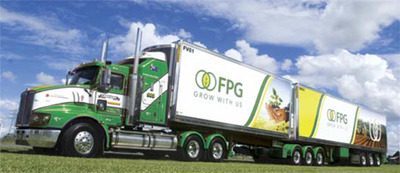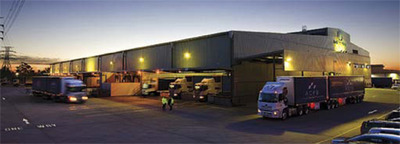CASE STUDY: Wireless in the warehouse
Thursday, 27 March, 2014
Fresh Produce Group, one of Australia’s largest providers of fruit and vegetables, urgently needed help to improve stock control and efficiency.
Established in 1991, Fresh Produce Group (FPG) has quickly grown into one of Australia’s largest and most innovative fresh produce providers, managing all aspects of procurement and supply from the farm gate directly to the customer’s plate. Today, the company’s network spans from farms in California and restaurants in Sydney to supermarkets in Hong Kong.
Management of such highly perishable goods as fruit and vegetables means that stock has to move fast, and in the right order. To make sure that information about stock location and details is accurate and instantly accessible, FPG installed a Motorola solution of a wireless network and mobile devices.
Replacing a tired system
FPG’s service centres are located at Sydney Markets, Sydney Arndell Park and Brisbane Markets. Each facility is purpose-built for the receipt, handling and dispatch of fresh produce, with the objective of providing efficient daily service and product supply to each of the major supermarket chains in Australia as well as leading independent retailers.
Sydney Markets in Flemington house the main warehouse as well as head office. The existing warehouse management system was not only old and tired but was also poorly designed and integrated. According to Malcolm Price, IT/systems manager at FPG, “infrastructure was just plonked in where it was convenient, and the equipment was not even commercial grade. The wireless network didn’t work throughout the facility, so it wasn’t well used and there were black spots. At times there were equipment failures with no available backup plan.
“We had lots of issues with stocktaking with the older system, such as poor visibility of where stock was and asynchronous updates to stock movements. Often we relied on a person’s memory as to where stock was.”
“So someone would be verbally directed to the location of stock, wasting the forklift driver’s time because it couldn’t be found.”

Mobile computing
The new infrastructure consists of a new wireless network, supported by Motorola AP-7131 wireless access points, which delivers the throughput, coverage and resiliency required for an all-wireless enterprise, at all three sites. The points provide support for FPG’s high-speed wireless data services. Furthermore, all access points can be centrally managed from an RFS6000 wireless RF switch located in the Sydney office.
As the points operate in adaptive mode, they can also resume functionality as a standalone access point in the event of loss of connectivity. The switch drives the access points, but if the switch fails for any reason the points become independent and can work for up to three days in this way. In the meantime the switch is repaired or replaced, so redundancy and reliability are assured.
The recommended devices were Motorola MC9190-G mobile computers, which are more rugged; more powerful; have a higher resolution display, better scanning performance and more scanning options than their predecessors.
The selection of the devices was partially based on the ability to customise the key face as FPG could choose the buttons to suit the application being used. Unused buttons could be mapped to software-specific functions.
Another particularly appealing factor was the robustness of the devices. “We saw that they can take a pounding and not break. We’re in quite a primitive environment so that’s important. They also need to handle temperature variations of between 18 and -2°, which they do well. We’ve had no issues,” says Price.
Throughout the Flemington warehouse, the old infrastructure was swapped out for a new network.
The Brisbane service centre is a new building, so FPG took the opportunity to set up new infrastructure from the beginning. Access points were installed, with Motorola handheld devices using software developed by FPG’s own in-house developer.
The Sydney Arndell Park service centre operates out of a 6000 m2 premises and had no pre-existing system, so was also installed from scratch.
“The rollout went well. It was very straightforward and it all worked. We just plugged the access points in and everything started working,” says Price.

The sweet taste of success
Locating stock and the attached data is much faster and based on accurate information, explains Price.
“One of the benefits is the improved ability to track stock, and better stock management is a major business benefit.
“For example, the truck arrives and uploads 10 pallets of pumpkins. Staff print a label which they attach to the pallet. They scan the label and update the database with details such as arrival time of stock and location. So if an order for pumpkins comes in, the pallet can be quickly located.
“Being in the highly perishable business, stock has to be in and out within hours. We can’t afford to hunt around looking for stock, which is what we used to do, especially when we have 6000 square metres of warehouse.
“The Wavelink server talks to the access points and it works marvellously. From my point of view the best thing is that it just works; I don’t have to worry about configuring devices. There used to be frequent dropouts, but now there are no complaints.”
The ability to remotely push out updates to devices is proving a great boon to FPG. “We can push out software updates so quickly. The developer is in Melbourne, but I can seamlessly update devices in Brisbane with the Wavelink software,” says Price.
The new system has also provided benefits in terms of staff management. Training staff is easier as new staff do not require extensive training on the new system or devices.
“We can also delegate to floor staff some of the tasks which used to be done by managers. For example, in the past staff had to be instructed to get the oldest stock first. Now they can be simply instructed to ‘pick pallet 10’ because that logic already exists in the software. We can even see how staff are performing and whether they are following instructions, and can build in key performance indicators for particular staff.”
Staff productivity can be measured by records of log-on and log-off times, as well as tasks completed such as numbers of stock picks. Staff management and work processes can be assessed with the detailed data now available.
User feedback indicates that staff have really embraced the new system, adds Price.
“The real success story is one of our warehouse managers who used to be very negative about the system’s capability. He’s now on the front foot with the extra functionality and is an advocate for putting it in some of the smaller sites.”
Wireless networks for mine management
Today's fleet management applications form the foundation for a future where driverless...
Wireless networks for mine management
Today's fleet management applications form the foundation for a future where driverless...
Interoperability for Tasmania's emergency services
Tasmanian police, fire and ambulance services can now communicate directly with each other,...






